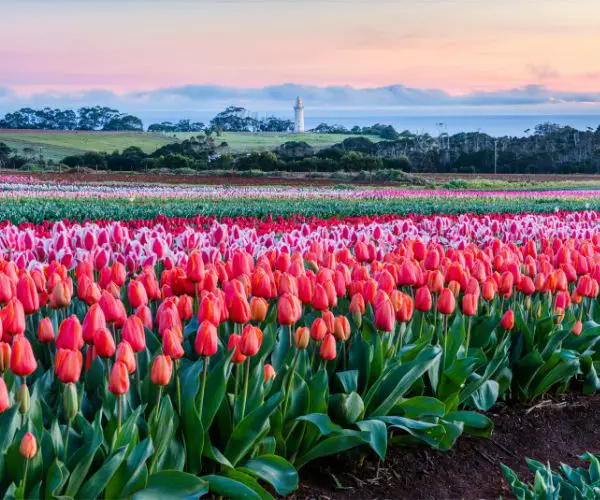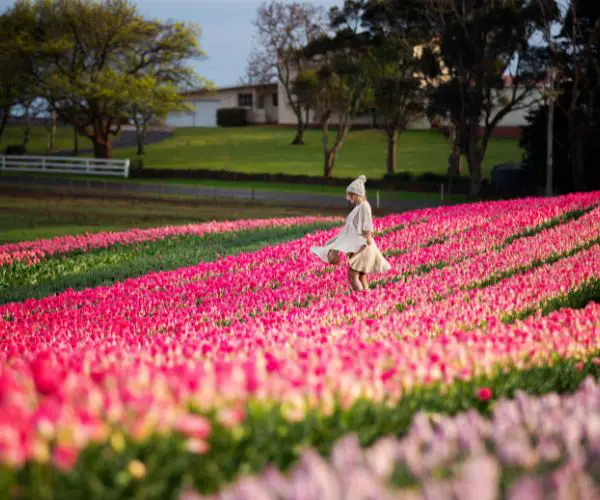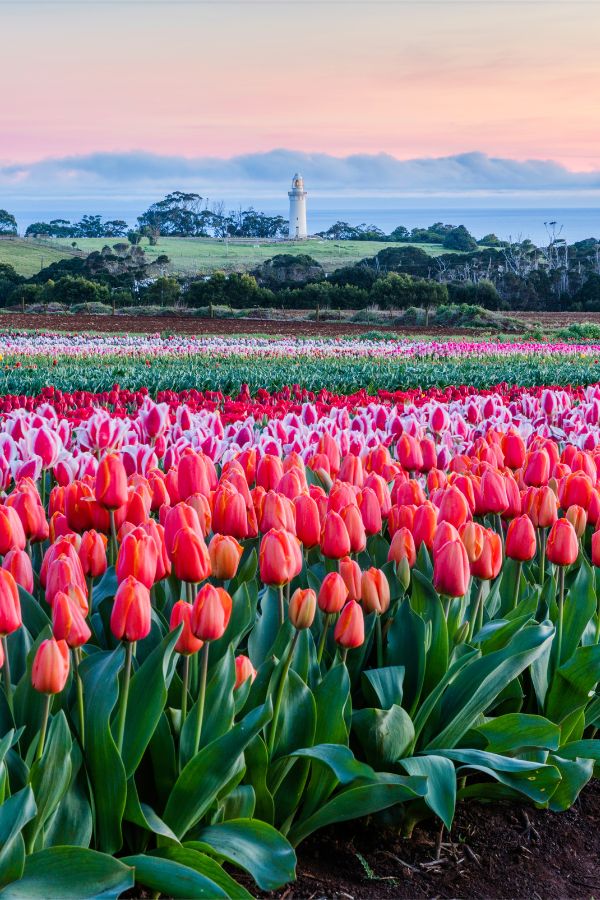Table Cape is a prominent geographical feature located on the north-western coast of Tasmania. It is a flat-topped plateau that rises 180 metres above sea level and extends for approximately 5 kilometres.
The history of Table Cape spans thousands of years, from the time of the Aboriginal Tasmanians to the arrival of European settlers and the development of the modern community.
Today many people visit to see the Table Cape Tulip Farm, with rows of different coloured Tulips that stand out from afar. Table Cape Lookout and Lighthouse are also popular attractions.

Table Cape History
The Aboriginal Tasmanians were the first people to live in the area around Table Cape. They were skilled hunters and gatherers who used the natural resources of the region to sustain themselves. The area around Table Cape was abundant in seafood, including shellfish, fish, and seals, as well as kangaroos and wallabies. The Tasmanian Aboriginal people also had a spiritual connection to the land, with Table Cape being an important site for ceremonies and rituals.
In the late 1700s and early 1800s, European explorers began to visit the north-west coast of Tasmania. The British navigator Matthew Flinders named Table Cape during his circumnavigation of Tasmania in 1798. The first European settlement in the area was established in 1826 when a group of convicts and soldiers arrived at nearby Circular Head. These early settlers used the fertile soil of Table Cape to grow crops and raise livestock, and the area became known for its agriculture.

In the mid-1800s, Table Cape became famous for its lighthouse, which was built in 1888. The lighthouse was the first in Tasmania to use a revolving light and was essential for guiding ships along the coast. Today, the lighthouse is still in operation and is a popular tourist attraction.
In the early 1900s, the town of Wynyard was established near Table Cape. The town grew rapidly, and by the mid-1900s, it was a thriving community with a variety of industries, including timber, fishing, and agriculture. The area remained an important agricultural region, with farmers growing crops such as potatoes, onions, and tulips.
Today, Table Cape is a popular tourist destination, known for its stunning views, agricultural produce, and historical landmarks. The area is particularly famous for its tulips, with the Table Cape Tulip Farm attracting visitors from around the world. The lookout and surrounding area is also a popular spot for hiking and birdwatching, with a variety of native plants and animals to see.

Key Visitor Information for Table Cape
Table Cape Weather
Before planning your visit to Table Cape, it is important to understand the type of weather conditions you can expect. The climate is classified as temperate maritime, which means it is relatively mild and wet throughout the year. The summer season, from December to February, is the warmest period, with average temperatures ranging from 12°C to 22°C. Autumn, from March to May, is mild with average temperatures ranging from 7°C to 16°C. Winter, from June to August, is the coldest period with average temperatures ranging from 3°C to 12°C. Finally, spring, from September to November, is cool with average temperatures ranging from 7°C to 16°C.
Directions to Table Cape
Table Cape is located approximately 12 km west of Wynyard, and 22 km east of Stanley. If you are travelling from Hobart, the best way to get there is to follow the Bass Highway to Burnie, then turn left onto the B18 Table Cape Road. If you are travelling from Launceston, take the Bass Highway to Burnie and then turn left onto the B18. If you are travelling from Devonport, take the B17 to Burnie and then turn left onto the B18.
Attractions & Things to do in Table Cape
In addition to the lookout point, there are several other attractions and things to do in the Table Cape area. These include:
Table Cape Lookout & Walk

The Table Cape Walk is a 1.6-km round-trip path that is generally regarded as easy, and it usually takes around 30 minutes to finish. It’s an excellent option for hikers and walkers, and there are likely to be few other visitors in the area. The route is well-maintained and easy to navigate, connecting the lighthouse and the lookout with stunning views of both the coast and the inland mountains. On clear days, the path’s height of 180 metres offers far-reaching views up and down the coast. Additionally, a picnic area is available at the trailhead, where visitors can enjoy the breathtaking views.
The Table Cape Lookout is a great place to admire panoramic views of the area and of Bass Strait.
Table Cape Tulip Farm

The Table Cape Tulip Farm is an awe-inspiring sight during the Spring season, with vast stretches of fields bursting with color that attract photographers from around the world. Although the tulips are grown for the Dutch market, where they bring a bright splash of color to the gloomy Autumn season, the farm can be found up the winding road that leads to the plateau. As you reach the top, you will be greeted by the entrance to the farm, surrounded by fields of purple Dutch iris and neat rows of Table Cape tulips.
This working farm, which plants more than 4 million tulip bulbs every April, operates year-round and the tulips bloom from late September until mid to late October. The tulip was first introduced to the area by Dutch immigrants who fled to Tasmania after WWII, and the plant’s hardiness makes it ideal for the region’s unpredictable weather conditions.
Things to do near Table Cape
In addition to the attractions in Table Cape, there are several other things to do near the lookout point. These include:
Fossil Bluff
Fossil Bluff is a popular geological site located a few kilometres east of the lookout point. Visitors can explore the rock formations and learn about the area’s rich geological history.
Wynyard Golf Club
The Wynyard Golf Club is located just a short distance from the lookout point and offers stunning views of the coastline. The course is open to visitors and is a great way to spend a relaxing afternoon.
Table Cape Accommodation
If you are planning to stay near Table Cape, there are several accommodation options available in the area. These include:
Table Cape Farm
Table Cape Farm is a working farm that offers self-contained accommodation in a charming farmhouse. The accommodation features a fully equipped kitchen, comfortable living area, and stunning views of the surrounding countryside.
The Waterfront Wynyard
The Waterfront Wynyard is a boutique hotel located in the nearby town of Wynyard. The hotel features comfortable rooms with waterfront views, as well as an on-site restaurant and bar.
Seabrook Hotel
The Seabrook Hotel is a historic hotel located in the nearby town of Somerset. The hotel features comfortable rooms, an on-site restaurant and bar, and a beautiful outdoor area.
If you are unable to find suitable accommodation in the immediate area, there are several options available in nearby towns such as Stanley and Wynyard.


